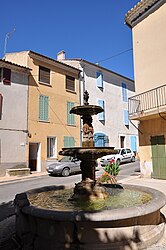You can help expand this article with text translated from the corresponding article in French. (December 2008) Click [show] for important translation instructions.
|
Quinson (French pronunciation: [kɛ̃sɔ̃]; Occitan: Quinçon) is a commune in the Alpes-de-Haute-Provence department in southeastern France.
Quinson | |
|---|---|
 The fountain in Quinson | |
| Coordinates: 43°42′11″N 6°02′26″E / 43.7031°N 6.0406°E | |
| Country | France |
| Region | Provence-Alpes-Côte d'Azur |
| Department | Alpes-de-Haute-Provence |
| Arrondissement | Forcalquier |
| Canton | Valensole |
| Intercommunality | Durance-Luberon-Verdon Agglomération |
| Government | |
| • Mayor (2020–2026) | Jacques Espitalier[1] |
Area 1 | 28.11 km2 (10.85 sq mi) |
| Population (2021)[2] | 408 |
| • Density | 15/km2 (38/sq mi) |
| Time zone | UTC+01:00 (CET) |
| • Summer (DST) | UTC+02:00 (CEST) |
| INSEE/Postal code | 04158 /04500 |
| Elevation | 353–584 m (1,158–1,916 ft) (avg. 380 m or 1,250 ft) |
| 1 French Land Register data, which excludes lakes, ponds, glaciers > 1 km2 (0.386 sq mi or 247 acres) and river estuaries. | |
History
editPrehistory
editIn the nearby Gorges du Verdon, there are a number of caves (known as "baumes"), which were occupied intermittently for over 400,000 years. The most significant of these caves is the "Baume Bonne", which has been studied by various archaeologists, including Henry de Lumley.
The Baume Bonne was occupied first during the end of the Lower Paleolithic, 400,000 years ago. It was occupied again 150–300,000 years ago. Tools made using the Levallois technique have been found dating from this era. Neanderthals inhabited the caves later, around 130,000 years ago. Remains of cave bears dating from this period have been found. The Neanderthals were eventually succeeded by Cro-Magnon men, who occupied the cave during the Upper Paleolithic. Finally, modern humans lived in the cave during Neolithic.
Population
edit| Year | Pop. | ±% p.a. |
|---|---|---|
| 1968 | 225 | — |
| 1975 | 251 | +1.57% |
| 1982 | 232 | −1.12% |
| 1990 | 274 | +2.10% |
| 1999 | 350 | +2.76% |
| 2007 | 430 | +2.61% |
| 2012 | 443 | +0.60% |
| 2017 | 417 | −1.20% |
| Source: INSEE[3] | ||
See also
editReferences
edit- ^ "Répertoire national des élus: les maires". data.gouv.fr, Plateforme ouverte des données publiques françaises (in French). 2 December 2020.
- ^ "Populations légales 2021" (in French). The National Institute of Statistics and Economic Studies. 28 December 2023.
- ^ Population en historique depuis 1968, INSEE



